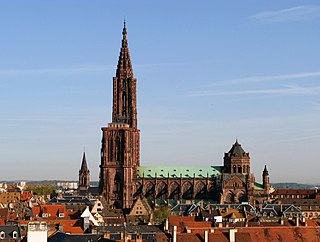
Strasbourg is the prefecture and largest city of the Grand Est region of eastern France, at the border with Germany in the historic region of Alsace. It is the prefecture of the Bas-Rhin department and the official seat of the European Parliament.

Alsace is a cultural region and a territorial collectivity in eastern France, on the west bank of the upper Rhine next to Germany and Switzerland. In January 2021, it had a population of 1,919,745. Alsatian culture is characterized by a blend of German and French influences.

Saverne is a commune in the Bas-Rhin department in Grand Est in north-eastern France. It is situated on the Rhine-Marne canal at the foot of a pass over the Vosges Mountains, and 45 km (27 mi) northwest of Strasbourg.

Bas-Rhin is a département in Alsace which is a part of the Grand Est super-region of France. The name means 'Lower Rhine', referring to its lower altitude among the two French Rhine departments: it is downstream of the Haut-Rhin department. Both belong to the European Upper Rhine region. It is, with the Haut-Rhin, one of the two departments of the traditional Alsace region which until 1871, also included the area now known as the Territoire de Belfort. The more populous and densely populated of the pair, it had 1,152,662 inhabitants in 2021. The prefecture is based in Strasbourg. The INSEE and Post Code is 67.

Alsace–Lorraine, officially the Imperial Territory of Alsace–Lorraine, was a former territory of the German Empire, located in modern-day France. It was established in 1871 by the German Empire after it had occupied the region during the Franco-Prussian War. The region was officially ceded to the German Empire in the Treaty of Frankfurt. French resentment about the loss of the territory was one of the contributing factors to World War I. Alsace–Lorraine was formally ceded back to France in 1920 as part of the Treaty of Versailles following Germany's defeat in the war, but already annexed in practice at the war's end in 1918.

Sélestat is a commune in the Grand Est region of France. An administrative division (sous-préfecture) of the Bas-Rhin department, the town lies on the Ill river, 17 kilometres (11 mi) from the Rhine and the German border. Sélestat is located between the largest communes of Alsace, Strasbourg and Mulhouse.
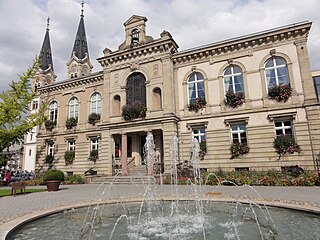
Illkirch-Graffenstaden is a commune in the Bas-Rhin department in Grand Est in north-eastern France. It is the second-largest suburb of the city of Strasbourg, and is adjacent to it on the south-southwest. Illkirch-Graffenstaden's population more than doubled in fifty years.
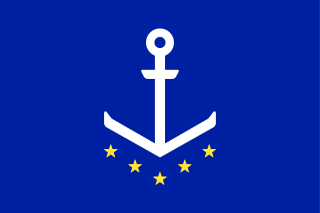
The Central Commission for the Navigation of the Rhine is an international organisation with five member countries, whose function is to encourage European prosperity by guaranteeing a high level of security for navigation of the Rhine and environs. Founded in 1815, it is the world's oldest international organization still in operation. It has been based in Strasbourg, France, since 1920. Lucia Luijten from the Netherlands has been its Secretary General since November 1, 2021.
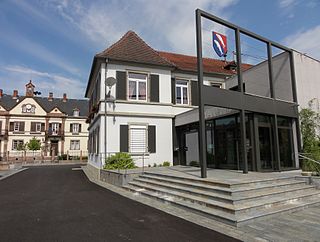
Huttenheim is a commune in the Bas-Rhin department in Grand Est in north-eastern France.

The Palais Rohan in Strasbourg is the former residence of the prince-bishops and cardinals of the House of Rohan, an ancient French noble family originally from Brittany. It is a major architectural, historical, and cultural landmark in the city. It was built next to Strasbourg Cathedral in the 1730s, from designs by Robert de Cotte, and is considered a masterpiece of French Baroque architecture. Since its completion in 1742, the palace has hosted a number of French monarchs such as Louis XV, Marie Antoinette, Napoleon and Joséphine, and Charles X.
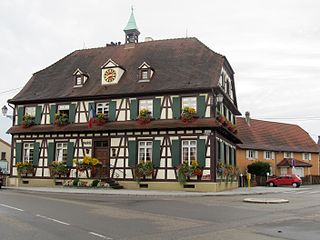
Gambsheim is a commune in the Bas-Rhin department and Grand Est region of north-eastern France, in the historical region of Alsace.

Hilsenheim is a commune in the Bas-Rhin department in Alsace in north-eastern France.

Strasbourg-Ville station is the main railway station in the city of Strasbourg, Bas-Rhin, France. It is the eastern terminus of the Paris-Est–Strasbourg-Ville railway. The current core building, an example of historicist architecture of the Wilhelminian period, replaced a previous station inaugurated in 1852, later turned into a covered market and ultimately demolished.
With over 20 million passengers in 2018, Strasbourg-Ville is one of the busiest railway stations in France, second only to Lyon-Part-Dieu outside of the Île-de-France.
The following is a timeline of the history of the city of Strasbourg, Alsace, France.

The Palais Universitaire in Strasbourg is a large, neo-Renaissance style building, constructed between 1879 and 1884 under the direction of the German architect Otto Warth. It was inaugurated in 1884 by Wilhelm I, Emperor of Germany. Through Avenue de la Liberté, it faces the equally monumental former imperial palace (Kaiserpalast).

The National Theatre of Strasbourg is a palace building on Strasbourg's Place de la République, now occupied by a theatre company of the same name, the National Theatre of Strasbourg.

Grand Est is an administrative region in northeastern France. It superseded three former administrative regions, Alsace, Champagne-Ardenne and Lorraine, on 1 January 2016 under the provisional name of Alsace-Champagne-Ardenne-Lorraine, as a result of territorial reform which had been passed by the French Parliament in 2014.

The Neustadt is a district of Strasbourg, Bas-Rhin, France. In 2017, the heart of the district was listed as a World Heritage Site by UNESCO, as an extension of the site including the older city centre and Strasbourg Cathedral. The district is a unique example of city planning, merging the Haussmannian model with elements of German architecture and urban planning.

Strasbourg is a city in the historic Alsace region on the left bank of the Rhine. Founded by the Romans in 12 BC, the city passed under the control of the Merovingians in the eighth century, and then became part of the Holy Roman Empire. Flourishing throughout the middle ages and Renaissance, it was conquered by Louis XIV in 1681. After having changed nationality four times between 1870 and 1945, Strasbourg today is a symbol of Franco-German reconciliation and European integration. The following is a detailed history of Strasbourg, France.

The Place de la République is one of the main squares of the city of Strasbourg, France. It is surrounded on three sides by five buildings only, of which none is residential: the Palais du Rhin, the National and University Library, the Théâtre national de Strasbourg, the Préfecture of Grand Est and Bas-Rhin, and the tax center Hôtel des impôts. All of these buildings are classified as monuments historiques. The fourth side of the square is devoid of buildings.




























